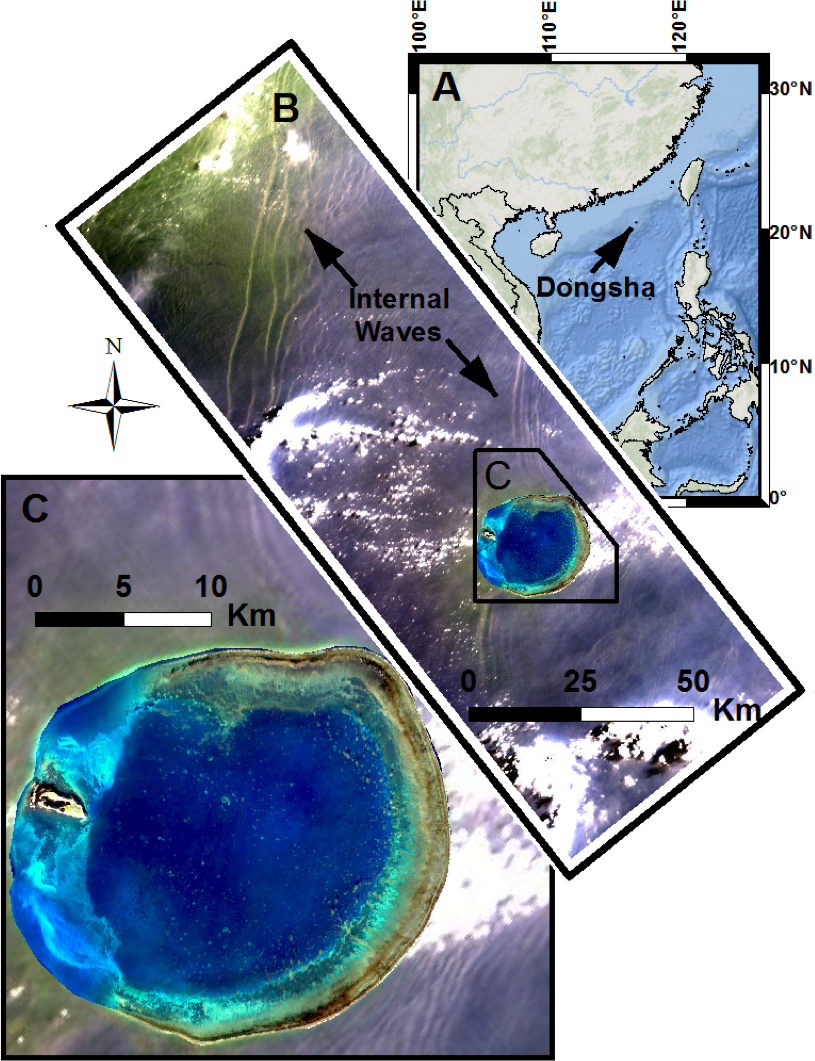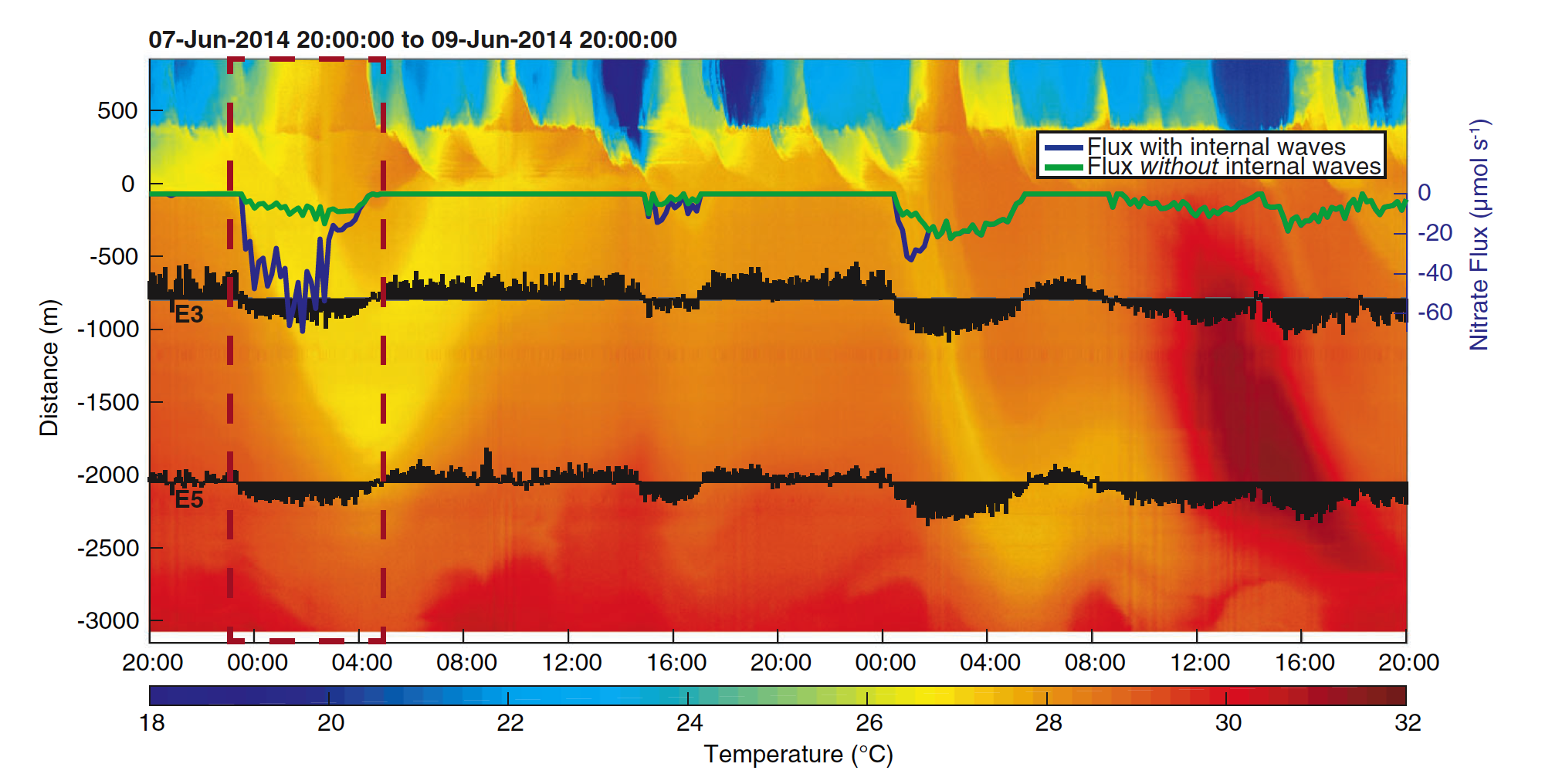What are internal waves?
Internal waves are waves that propagate along density gradients within a fluid. Similar in many respects to surface gravity waves, which travel along the sharp density interface between air and water, internal waves travel along density gradients within the ocean. Perturbations to these density gradients are restored by gravity, generating a propagating wave.
Globally, internal waves play an important role in the ocean, delivering nutrients to surface waters that stimulate the growth of phytoplankton, the base of the oceanic food web. Generated largely by the interaction of the tide with ocean floor topography and wind, internal waves can carry the energy from these forces across entire ocean basins. As internal waves shoal up onto the continental shelf, they interact with the topography, and in much the same way as a surface gravity steepens and breaks on the shore, internal waves can steepen and dissipate their energy on the shelf. As the internal waves steepen they transform into nonlinear internal waves and can take many forms (e.g. “solitons”, “bores”, “boluses”) – all of which have the potential to bring deep water that has different properties (likely colder, higher in nutrients, lower in oxygen, lower in pH?) across the shelf and into shallower waters.
What we’re studying
Our work examines the dynamics of internal waves on the shelf. Specifically, we are interested in understanding the evolution of internal waves across the shelf, the transport of deep waters onto the shelf by nonlinear internal waves, the spatial and temporal characteristics of turbulent mixing driven by internal waves, and the biological implications for internal wave driven variability on benthic communities.
Currently, we are working researchers at National Taiwan University and National Sun Yat-Sen University in Taiwan, Woods Hole Oceanographic Institution, and at the University of California, San Diego to study the effect of internal wave forcing on a remote coral atoll in the South China Sea, Dongsha Atoll. Dongsha Atoll is a vibrant reef system that sits in the path of some of the largest internal waves measured in the world’s oceans. We want to understand how internal waves shape the physical and chemical environment in which these corals thrive. To do this we are deploying a series of instruments on the reef to track how the internal waves bring deep water onto the reef and working with coral ecologists to understand how the corals are responding.

One of the exciting aspects of this study is a new instrument that we are using to capture internal wave dynamics from the fore reef onto the reef flat – a Distributed Temperature Sensing (DTS) System. The DTS system couples a pulsed laser with an optical fiber to measure temperature along the length of the bottom-mounted cable from meter-to-kilometer spatial scales with a sampling period of seconds. These measurements of along-bottom temperature provide an unprecedented, continuous view of the physical dynamics at play in the coastal ocean. Below are results from a publication by CDL graduate student, Emma Reid, using the DTS sensor to examine internal wave influence on the thermal and nutrient environment on the Dongsha reef flat.

Related Publications
(bold are members of CDL; * is a student or postdoctoral author)
Sinnett, G*, SR Ramp, YJ Yang, M-H Chang, S Jan, KA Davis. (2022) Large amplitude internal wave transformation into shallow water. Journal of Physical Oceanography, 52(10), p 2539–2554, https://doi.org/10.1175/JPO-D-21-0273.1.
Rogers, J, F Mayer, KA Davis, O Fringer (2022) On internal tides driving residual currents and upwelling on an island. Journal of Geophysical Research, Oceans, 127, e2021JC018261, https://doi.org/10.1029/2021JC018261.
Ramp, SR, Y-J Yang, M-H Chang, KA Davis, G Sinnett*, FL Bahr, DB Reeder, DS Ko, and G Pawlak. (2022) Solitary waves impinging on an isolated tropical reef: Arrival patterns and wave transformation under shoaling. Journal of Geophysical Research, Oceans, 127(3), e2021JC017781.
Chang, M-H, Y-H Cheng, YJ Yang, S Jan, SR Ramp, DB Reeder, W-T Hsieh, DS Ko, KA Davis, H-J Shao, and R-S Tseng. (2021) Direct measurements reveal instabilities and turbulence within large amplitude internal solitary waves beneath the ocean. Communications Earth & Environment, 2 (1), 1-10.
Davis, KA, RS Arthur, EC Reid*, JS Rogers, OB Fringer, TM DeCarlo*, and AL Cohen. (2020) Fate of internal waves on a shallow shelf.Journal of Geophysical Research Oceans. DOI: 10.1029/2019JC015377
Reid, E*, TM DeCarlo*, A Cohen, GTF Wong, S Lentz, A Safaie*, A Hall*, and KA Davis. (2019) Internal waves influence the thermal and nutrient environment on a shallow coral reef. Limnology & Oceanography, doi: 10.1002/lno.11162
DeCarlo, TM*, AL Cohen, GTF Wong, KA Davis, G Lohmann, K Soong. (2017) Mass coral mortality under local amplification of 2°C ocean warming. Scientific Reports, 7, 44586.
DeCarlo, TM*, AL Cohen, GTF Wong, F Shiah, SJ Lentz, KA Davis, KEF Shamberger, and G Lohmann. (2017) Community production modulates coral reef pH and the sensitivity of ecosystem calcification to ocean acidification. Journal of Geophysical Research, Oceans, 122(1), 745-761.
DeCarlo, TM*, KB Karnauskas, KA Davis, GTF Wong (2015). Climate modulates internal wave activity in the Northern South China Sea Geophysical Research Letters, v. 42, p. 831-838
Davis, KA and SG Monismith (2011). The modification of bottom boundary layer turbulence and mixing by internal waves shoaling on a barrier reef.Journal of Physical Oceanography, v. 41, p. 2223-2241
Davis, KA, JJ Leichter, JL Hench, SG Monismith (2008). Effects of western boundary current dynamics on the internal wave field of the Southeast Florida shelf. Journal of Geophysical Research, v. 113, p. C09010
